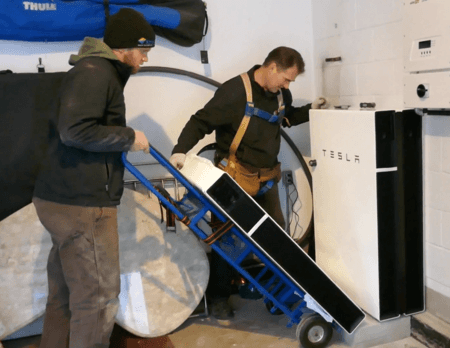Tesla Powerwalls and PV Solar Installation VIDEO (Nov 2018)
Apr 22, 2021

President Steve Dyck chats with a Guelph Solar client in Oakville, Ontario during the installation of three Tesla Powerwalls, including a Powerwall unboxing. Designed, engineered and installed by Guelph Solar, the residential system has 27 kW of PV solar panels, two inverters and three Tesla Powerwalls. Steve Dyck calls it “incredibly elegant technology.” Each Powerwall is 13.5 kWh and the homeowner estimates three of them will power his home for 40 hours if the grid were to go down, including charging his three Tesla electric vehicles (not taking into account that the solar system would recharge the Powerwalls during that time). Steve Dyck also demonstrates the home’s grid configuration. He talks about the Tesla Gateway and how it monitors and intelligently routes power between the Powerwalls, the grid, the PV solar system and the requirements of the household.
Transcript:
Hi, it's Steve Dick with Guelph Solar. We're here with Mark, and we're installing some Tesla Powerwalls. So far, we've got one installed, with two more to go. We're going to be unboxing them here in just a minute, and it's amazing how compact this power is. We've got 13.5 kilowatt-hours of power in one Tesla Powerwall. We're going to be adding two more, and the house should be able to go for 40 hours with the three Powerwalls, which is pretty neat, especially with the grid being down.
Without the grid, that's pretty cool—and no solar! Right, it’s worst-case scenario, which is great. You’ll also be able to charge your car. We've got the 7.6-kilowatt inverter, and depending on what's being used in the house, the power will either go into the Tesla Powerwall or directly into the house.
It's also great that we have all the flat roofs. We're going to put up about 64 panels, which will give you about 27 kilowatts of solar power. And look at how little space it takes up when you think about it. Incredibly elegant technology. It looks great as well, plus it has the app that allows you to see what's happening with the Powerwalls and the Tesla at the same time, which is very cool.
Alright, let’s go ahead and open the box. Here we go. Look at that, a beautiful Powerwall just sitting there, awesome. Wow, that’s great. Is this where you say, “Thank you, Elon”? You have to say, “Thank you, Elon!” What incredible technology you’ve brought to my home, and thanks to Guelph Solar for their leadership. We really appreciate it.
The power for this home comes in from the street through this splitter, and this is the Tesla Gateway. If the grid were to go down, this gateway would disconnect the home from the street to keep everyone safe. The gateway also includes some communication meters, which measure how much power the home is using.
The power can come from the Powerwalls back to the gateway and into the home, powering the lights, furnace, and all the items backed up by the Powerwall. We also want to make sure that we’re not sending power back onto the grid from the batteries. If the batteries need to be charged, they can be charged from the sun using the solar equipment, or if we choose, they can be charged from the grid as well.
